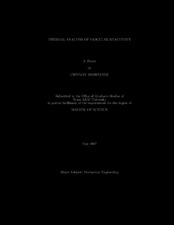| dc.contributor.advisor | Ley, Obdulia | |
| dc.creator | Deshpande, Chinmay Vishwas | |
| dc.date.accessioned | 2010-01-14T23:57:15Z | |
| dc.date.accessioned | 2010-01-16T01:39:18Z | |
| dc.date.available | 2010-01-14T23:57:15Z | |
| dc.date.available | 2010-01-16T01:39:18Z | |
| dc.date.created | 2007-05 | |
| dc.date.issued | 2009-05-15 | |
| dc.identifier.uri | https://hdl.handle.net/1969.1/ETD-TAMU-1342 | |
| dc.description.abstract | Cardiovascular disease (CVD) is the leading cause of death in the United States.
Analysis of vascular reactivity (VR) in response to brachial artery occlusion is used
to estimate arterial health and to determine the likelihood of future cardiovascular
complications. Development of a sensitive technique to assess VR is fundamental
to the field of preventive cardiology. The conventional technique to study VR is
by monitoring arterial diameter changes during hyperemia following occlusion using
ultrasound based methods.
Such measurements require highly qualified technicians and expensive equipment;
and are complicated by signal noise introduced by motion and posture among others.
It is well known that tissue temperature changes are a direct response to variations
in blood flow, and it has been observed in small clinical studies that variations in
fingertip temperature during brachial artery occlusion and subsequent hyperemia is
a simple surrogate for the measurement of vascular reactivity and endothelial dysfunction. Given the promising nature of thermal monitoring to study VR, this thesis
focuses on the analysis of the underlying physics affecting fingertip temperature during vascular occlusion and subsequent hyperemia. I will quantify the contribution of
hemodynamic, anatomical and environmental factors over digit temperature changes,
which will serve to determine the sensitivity of the digital thermal monitoring (DTM)
technique.
I have quantified the effect of several contributing factors to fingertip temperature
and DTM results. The aims of this thesis focus on: (1) creation of a mathematical model of heat transfer at baseline, during, and after a reactive hyperemia test; and
(2) validation of the model and experimental analysis of thermal and flow parameters
in healthy volunteers.
The proposed project is an innovative study that intends to show and quantify
the relationship between VR and digital thermal reactivity, translating mathematical
models based on the physics of heat transfer and fluid mechanics to clinical application. The parametric studies performed with the zeroth order model served to
separate the contribution of environment and blood flow over the temperature curves
measured during brachial artery occlusion. The thermal models developed were able
to reproduce the trend of the temperature response observed experimentally at the
fingertip. | en |
| dc.format.medium | electronic | en |
| dc.format.mimetype | application/pdf | |
| dc.language.iso | en_US | |
| dc.subject | Vascular reacitivty | en |
| dc.subject | Digital thermal monitoring | en |
| dc.subject | Endothelial dysfunction | en |
| dc.subject | Reactive hyperemia | en |
| dc.title | Thermal analysis of vascular reactivity | en |
| dc.type | Book | en |
| dc.type | Thesis | en |
| thesis.degree.department | Mechanical Engineering | en |
| thesis.degree.discipline | Mechanical Engineering | en |
| thesis.degree.grantor | Texas A&M University | en |
| thesis.degree.name | Master of Science | en |
| thesis.degree.level | Masters | en |
| dc.contributor.committeeMember | Banerjee, Debjyoti | |
| dc.contributor.committeeMember | Chen, Hamn-Ching | |
| dc.type.genre | Electronic Thesis | en |
| dc.type.material | text | en |
| dc.format.digitalOrigin | born digital | en |


